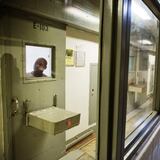A Virginia county whose police officers helped other law enforcement agencies clear a Washington, D.C., park ahead of a visit from President Donald Trump has pulled its officers out of the District of Columbia.
According to the Arlington County, Virginia, board, its officers were used “for a purpose not worthy of our mutual aid obligations.” Arlington officers reportedly joined a team of federal law enforcers using chemical agents and flash bangs to forcibly remove a large group of peaceful protesters from Lafayette Park.
That cleared a path for Trump, vowing a crackdown from the Rose Garden, to walk in front of the White House over to St. John’s Church, which had been damaged in earlier protests. Trump then posed with a Bible for a few minutes.
»RELATED: The Insurrection Act of 1807 has never been used in 21st century
County Board Chair Libby Garvey said on Twitter she is “appalled” the mutual aid agreement was abused “for a photo op.” D.C. Mayor Muriel Bowser, for her part, said Tuesday that the District of Columbia never put out a call for mutual aid.
In a phone interview with The Associated Press, Garvey said the aid request came from U.S. Park Police, and that the agencies have provided aid to each other routinely over the years. She said Arlington Police were helping in the District on Saturday and Sunday without incident.
What was unacceptable Monday, she said, was using officers to facilitate “a press op.”
Across the nation, cities were engulfed in more violence and destruction.
In New York City, nonviolent demonstrations were punctuated by people smashing storefront windows near Rockefeller Center and breaching the doors into the storied Macy’s store on 34th Street, littering parts of Manhattan with broken glass. A vehicle plowed through a group of law enforcement officers at a demonstration in Buffalo, injuring at least two.
Demonstrations erupted from Philadelphia, where hundreds of protesters spilled onto a highway in the heart of the city, to Nashville, where more than 60 National Guard soldiers put down their riot shields at the request of peaceful protesters who had gathered in front of Tennessee’s state Capitol to honor George Floyd.
The unrest in Minneapolis appeared to stabilize on the same day Floyd's brother made an impassioned plea for peace at the location where a white police officer put his knee on the handcuffed black man's neck until he stopped breathing last week.
The death toll from the unrest began to mount, including two people killed in a Chicago suburb. The police chief in Louisville, Kentucky, was fired after a beloved restaurant owner was killed by police and National Guard enforcing a curfew.
An officer was shot shortly before midnight near the Circus Circus casino in Las Vegas. Police had no immediate word on the officer’s condition.
Four officers were shot in St. Louis, where police said they were expected to recover.
Trump, meanwhile, portrayed himself as a hard-nosed, law-and-order president, threatening from the White House Rose Garden to deploy “thousands and thousands” of U.S. troops. Then he made a surprise walk across Lafayette Park to a house of worship known as “The Church of the Presidents.”
The photo op was condemned by Episcopal Bishop Mariann Edgar Budde.
“The president just used a Bible and one of the churches of my diocese as a backdrop for a message antithetical to the teachings of Jesus and everything that our church stands for,” she said.
The president, seeking his second term in office, vowed to use more force to stop the violence. “If governors don’t deploy the National Guard in sufficient numbers to “dominate the streets,” Trump said, the U.S. military would step in to “quickly solve the problem for them.”
“We have the greatest country in the world,” the president declared. “We’re going to keep it safe.”
A military deployment by Trump to U.S. states would mark a stunning federal intervention rarely seen in modern American history. It drew comparisons to 1968, when Richard Nixon ran as the law-and-order candidate in the aftermath of riots following the assassination of Martin Luther King Jr.
Minutes before Trump began speaking, police and National Guard soldiers began removing hundreds of protesters from Lafayette Park, across the street from the White House.
Five months before Election Day, the president made clear that he would stake his reelection efforts on convincing voters that his strong-arm approach was warranted to quell the most intense civil unrest since the 1960s.
As the crowd of protesters grew, Attorney General William Barr arrived in Lafayette Park to look over at the demonstrations and the swarm of law enforcement. Once his path was cleared, Trump then walked through the park and held up a Bible, posing for photos with a group of advisers.
New York Gov. Andrew Cuomo said Trump “used the military to push out a peaceful protest so he could have a photo op at a church.”
Earlier Monday, Trump told the nation’s governors in a video conference that they “look like fools” for not deploying even more National Guard troops. “Most of you are weak,” he said.
“You’ve got to arrest people, you have to track people, you have to put them in jail for 10 years and you’ll never see this stuff again,” Trump said.
If he is elected, former Vice President Joe Biden, the presumptive Democratic presidential candidate, vowed to address institutional racism in his first 100 days in office. He met in person with black leaders in Delaware and also held a virtual meeting with big-city mayors.
Biden said hate emerges “when you have somebody in power who breathes oxygen into the hate.”
More than 5,600 people nationwide have been arrested during the last week for such offenses as stealing, blocking highways and breaking curfew, according to a count by The Associated Press.
About the Author
